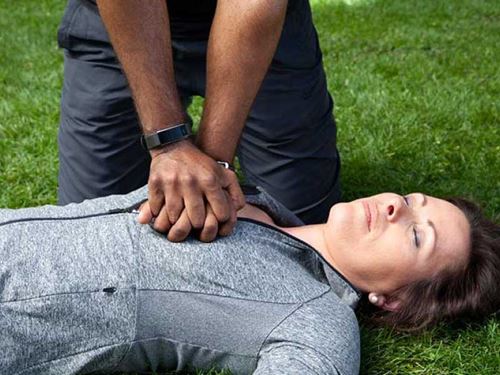Experts urge changes to improve rates of bystander CPR for women

Cardiac arrest is usually fatal if action isn’t taken immediately. But despite recent gains, less than 40% of U.S. adults receive bystander CPR.
If you’re a woman, the numbers are even worse.
While estimates vary, one study found women who experience cardiac arrest in a public setting are 27% less likely than men to receive bystander CPR. In October, the American Heart Association issued updated guidelines for CPR calling for training that removes “gender-related barriers” in order to improve rates of bystander CPR performed on women.
“This is a big issue and we need to target it thoughtfully, aggressively and quickly. Addressing it will save people’s lives,” said Dr. Sarah Perman, an associate professor of emergency medicine at the University of Colorado Anschutz Medical Campus.
Guidelines for bystander CPR, or cardiopulmonary resuscitation, are the same regardless of gender: Call 911, and press hard and fast in the center of the chest, for 100 to 120 compressions per minute, at least two inches deep, until Emergency Medical Service workers arrive.
Experts suggest several possible reasons why women are less likely than men to get bystander CPR. One big reason involves public image. Since men experience cardiac arrest more often than women, bystanders often mistake its symptoms in women, Perman said.
“They think ‘Maybe she just fainted’ or ‘Maybe there’s some other trigger’ for what’s making her unresponsive,” said Perman, who has studied CPR disparities. “It’s really important that we normalize the impression that women also do have cardiac arrest.”
Another reason is that since women are typically smaller than men, some bystanders fear they’ll hurt them by doing chest compressions. AHA’s updated guidelines recommend lay rescuers initiate CPR on any person with presumed cardiac arrest, since the risk of harm from CPR is low even if their heart hasn't stopped beating.
While Perman hasn’t seen statistics on injuries to women caused by CPR, “the benefit of CPR definitely outweighs the risk of injuries,” she said. “Everyone can heal from a bruised rib or a lung injury, but the odds of recovering from cardiac arrest are much lower without CPR.”
Another potential barrier is a reluctance of bystanders to perform CPR on women for fear they’ll be accused of inappropriate touching or sexual assault.
Perman said the fear is a classic example of “an over-sexualization of women’s bodies. CPR is a medical procedure. It’s not something to be thought of in that fashion.”
She said she has never heard of anyone being arrested or sued for performing CPR. “Good Samaritan laws basically protect you from any litigation if you are rendering aid to a person,” she added.
The growing public knowledge of “Hands-only CPR,” first introduced in 2008, could encourage higher participation rates from people who are leery of performing mouth-to-mouth resuscitation on women, Perman said.
She applauded recent efforts to use female CPR mannequins with breast tissue and women’s clothing. “From a training standpoint, it’s exciting to watch it being done on an anatomically female chest instead of a masculine-looking torso. This needs to be translated into community-based CPR training.”
In the past, women were hugely underrepresented in CPR educational materials, Perman said. While that disparity has since improved, there is still plenty of work to done to raise the rates of bystander CPR being performed on women, she said.
“We have to address public perception, or misperceptions, head on,” Perman said. “Cardiac arrest affects both men and women. A woman who collapses and has no pulse is just as deserving of CPR as a man. This is how we will improve outcomes for women who suffer cardiac arrest.”






